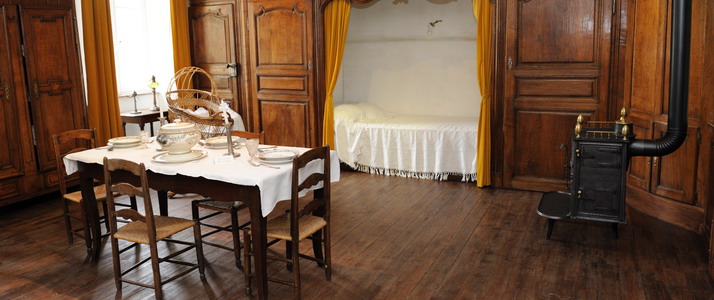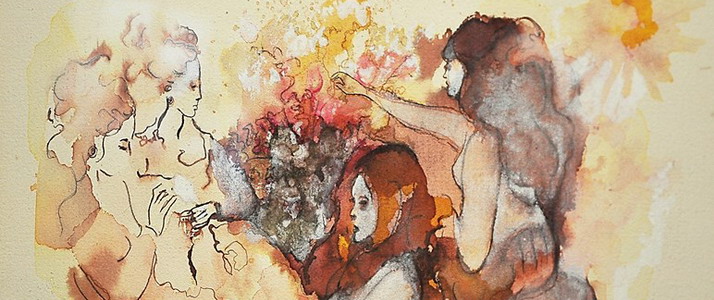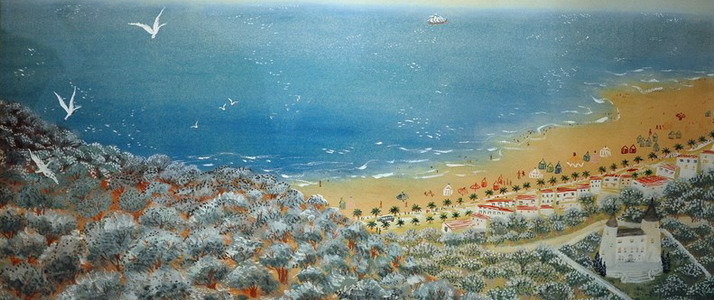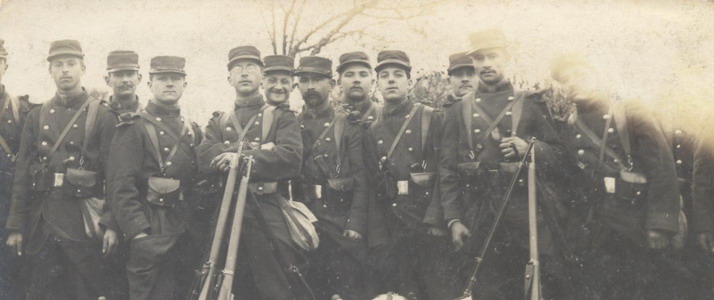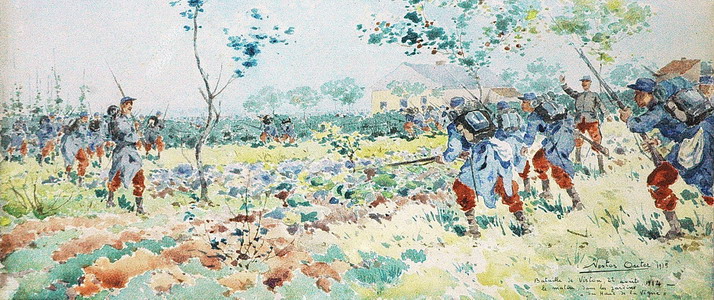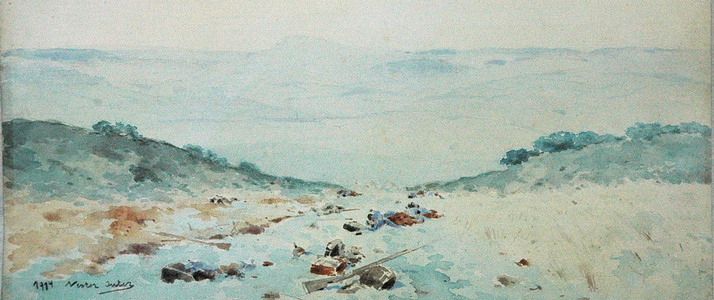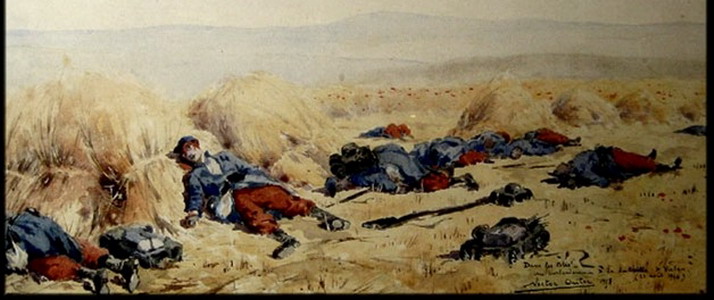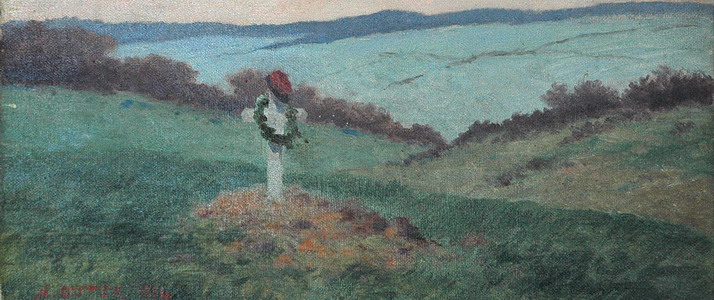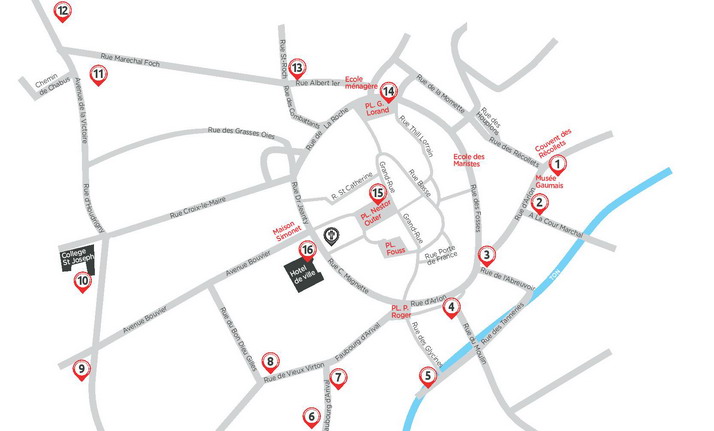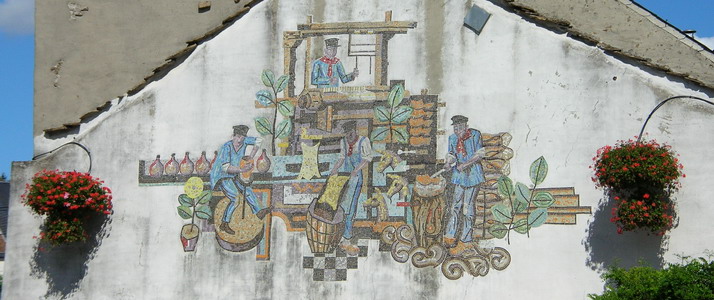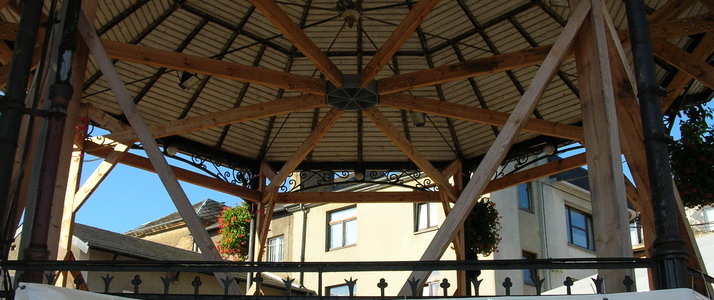Nestor Outer, from travels to memory lane
22
juil
2015
Par Fanny Lardot 22 juillet 2015 Catégories Facts and Historical sites Pas de commentaires
In Virton, the name of Nestor Ouster inevitably evokes something to the people of Gaume. The prolific and marginal artist from the beginning of last century gave his name to the town square and to the Athénée royal.(Secondary school) Furthermore, the Musée gaumais has republished and revisited the rare and very searched after book « Les Larmes Gaumettes » co-written by Outer, in the framework of the First World War centennial commemorations.
It also offers, since March, a major exhibition of a large number of painting works by the artist.
In this year of commemoration, this article’s goal is to define the important moments of his life and of his works and also his implication in the battle of the borders (August 1914) as a war correspondent.
A childhood in Gaume
Charles-Martel-Nestor was born in Virton on 2 April 1865. Son of shopkeepers Joseph Outer, 39 years, and Marie-Delphine Calin, 30 years, Nestor spends his childhood with his two elder brothers and his younger brother in the little town of Virton that is slowly coming out of its isolation thanks to the railways (1872). The country’s centre but also France, are now accessible to travellers ( Virton’s railway station is built in 1884).
In this late 19th century, thriving metallurgy flirts with family agriculture at the rhythm of a mild climate. As for cultural life, it organizes itself as it can in the small villages that do not lack initiatives (bands, theatre troops, local festivities , etc.).
The attraction to painting
As from his young age, Nestor picks up the paint brush. In 1871, at the age of 6 only, he represents the battle of Reischshoffen, one of the battles of the Franco-Prussian war of 1870. This triggers his mind; he wants to learn, understand and practice art. He then abandons his studies at the local school, that has now become the secondary school named after him, at the great displeasure of his father who already saw him as a shopkeeper. A compromise is reached: Nestor will go to the Academy of Fine Arts if his diploma allows him a professional future.
After Louvain, it’s in Brussels that he continues his artistic training. He then joins the workshop of Jean-François Portaels, considered as the father of the Belgian Orientalist school.
The young artist gives his preference to the watercolour technique that he uses in 1885 in his « Effet de neige » (Snow effect). Close to 300 works are listed in the 1988 catalogue. He also produces some thirty oil paintings during his life, procedure that is however favoured in and by the academies.
What are his preferred subjects?
The Gaume region inspires him since his early childhood, its rivers and forests alike. The typical villages, the green landscapes, the bright colours, the rural atmosphere are as many reasons to stop for a moment and take out his painters palette. Water seems to be his main element.
The names of his paintings evoke this rural ambiance : « September evening » « Village entrance », « Walloon land », « The washerwoman », etc. He also likes hunting, subject that he deals with in other works such as « Wounded duck » or « Snow landscape with hunter ».
Outer, the traveller and the Orientalist
Avid of encounters and novelty, Nestor Outer sojourns, a few times, in the French capital where artists of all sorts swarm. He rubs shoulders with celebrities (Gauguin, Utrillo, Toulouse-Lautrec, Aristide Bruant), as well as theatre people such as Maurice Donnay. Paris and its art world open up to him. This Bohemian life and friendships slowly change his artistic style and forge an atypical character.
Attracted by the Orient and its far away regions, he sails off to sunny destinations, on the edges of the Mediterranean (Spain, Greece, Italy, etc.) or North Africa (Algeria, Syria, Lebanon and Egypt). He searches for novel luminosities and exoticism and is fascinated by the vivid and crude light of these territories. These flavours and colours are set in his paintings. (« A street of the Casbah in Algiers ») and his story-telling(« A cruise in the Mediterranean », « Country of thirst », 1901). He’ll even bring to Gaume from his eventful journeys a monkey that will reinforce his reputation as an original if not wild artist.
His life as a local in Virton
The artist does not however forget his native Gaume. In 1890, at the end of his studies, he is appointed teacher of drawing. Enamoured of liberty, he sometimes finds it hard to adapt to rules and timetables. However, his greatest pleasure is to create vocations within his students, as was the case for Camille Barthélémy (1890-1961), other major painter and engraver of Virton.
Still living with his parents, Nestor isolates himself in the workshop built by the latter in the actual rue des Glycines. True cave of Ali Baba, the place is littered with objects and souvenirs acquired year after year during his travels. The artist even installs a Moorish living room. He ends up living there after the death of his father in 1910.
Integrated in his town, the painter participates in artistic movements and local life, mainly from 1895 to 1911. His notoriety growing, he exhibits more and more in many Walloon towns such as, Spa, Charleroi, Arlon, Huy, etc. Sometimes comedian, he tries himself in writing plays and playlets in dialect.
One of his main prides was the creation of the newspaper « Le Gaumais » (1903-1904). This literary and humorous weekly allows him to share his opinions. Produced in collaboration with Numa Pletinckx, it does not however succeed in enthusing crowds because of the geographic distance of Virton and its readers.
1914, the battle of the Borders
The battle of the Borders is the first general confrontation of the Great War. For the Belgians, entering the war is a surprise because, since its creation, the country is obliged to maintain neutrality in case of conflict. This statute must be respected by the neighbouring countries who are the guarantors, as was the case during the Franco-Prussian war of 1870.
In this early August 1914, the German objective is to invade Belgium in order to bypass, by the North, the French army concentrated along the Franco-German border and to take Paris. They must act swiftly to thwart the Russian mobilisation in the East.
The Belgian mobilisation, ordered on 31 July following the events of June 1914, assembles close to 200 000 men, against 3 840 000 for Germany. The defence of the country rests on three fortified towns: Namur, Antwerp and Liège.
On 5 August, Belgium is assaulted by a superior German army, superior in all ways (numbers and armament). The 12 forts fall one after the other. On 16 August, Hollogne, the last of them, surrenders, leaving the country to the oppressors delayed in their progression. The capital falls four days later. A very strong resentment develops on the German side against the Belgians who hold with the French.
While the Germans continue their breakthrough, the Franco-British troops launch an offensive in a number of regions of which the Ardennes. The French intend to advance towards the river Meuse to then surround the enemy and easily beat him. In reality, this strategy leads to a collision with the German forces. The battle of the Borders is launched.
Due to the conflict, Outer, the traveller, is obliged to set down his luggage for a long moment in Virton, that has become a stage zone for the German troops and convoys . The regime applied reduces all movements of the inhabitants. Its favourable statute permits it to be relatively spared by the Occupation.
The battles in words and pictures
During the four years of occupation, the artist is a witness of the tragic events. He uses his art to transmit messages to his contemporaries. Paintings, literature and journalism are as many means to permit him to make known the events of the very end corner of Belgium. To do this, he criss-crosses the region, goes to the still smoking battlefields, draws what he sees, meets survivors and continues his work in his workshop.
As from 30 July 1914, he undertakes the writing and description of his everyday life in notebooks, till November 1918. The12 notebooks make up the « Journal d’un Bourgeois pendant la guerre » (Journal of a burger during the war) which is a war chronicle under the German occupation. It will later serve as the base of a more consequent book written in collaboration with Léon Thiry, director of the steelworks of Halanzy, « Les Larmes Gaumettes » (1919).
This more general work represents a first synthesis of the conflict a sort of assessment of the events as the canon Jean Schmitz and dom Norbert Nieuwland will do soon after (Documents to serve the history of the German invasion) Outer and Thiry replace the whole in a context as well military as social. They deal with, for example, the history of the war, the massacres of inhabitants and of resistance fighters of the south of the province, the list of executed, of deported and of soldiers of Gaume , of help committees, etc. The amounts gathered go to help poor children.
Words alone do not suffice to carry a message. That is why the paint brushes accompany the artist in the battlefields for a number of days after the battle. Outer is a landscape artist stimulating the subject in its immediate environment. What remains of the confrontations? Bloody dead mixed amongst each other, villages in ruins , graves lost in the nature, a wounded and disfigured forest and the confused population.. Outer bears witness to the horror of war in all its aspects: « After the battle, 22 August 1914″, « During the battle », « Forwards », » Burning Ethe », « Evening on the battlefield », « In the wheat », etc.
Post-war years
This war deeply affected him, so much so that he tries to forget. He does not take part in the commemorations, he travels less and less and his paintings are touched by melancholy.
However, it’s during this period, in 1921, that Nestor Outer marries Marie-Constantine Michel (1891-1980) from Visé. It is she who from now on organizes his exhibitions (Liège, Arlon, Charleroi, Virton, Longwy, Nancy and the Grand-Duchy of Luxembourg). Sick and progressively paralysed the artist develops a pictorial ambiance corresponding to his state of health (foggy landscapes, marches, etc.).He dies in Virton on 30 April 1930.
According to some specialists, he can be considered as one of the 5 best Belgian painters of the early 20th century.
Nestor Outer itinerary through Virton
Nestor Outer itinerary in Virton
1. The civilian old people’s home, now the Musée gaumais, served as an aid station as from the first encounters of August 14.
2. The Continental hotel housed during the four years of occupation, the «Meldeamt » i.e. the census and population control office. It was also the house of Omer Bodson, a friend of Nestor Outer.
3. The Franklin theatre inaugurated in 1913 and requisitioned by the Germans who named it« Kino » and made it a cinema. Inscriptions in German are still visible in the banquet room of the actual restaurant.
4. The hôtel du Cheval Blanc managed by Eugène Ribonnet welcomed during the « Belle Epoque », Nestor Outer and many other burgers. Throughout the war, the artist, still a bachelor continues to have his meals there. German officers also ate there.
5. The rue des Tanneries reminds us that the leather craftsmen were settled there along the river Ton. It leads to Nestor Outer’s workshop and to the house of the artist Marguerite Brouhon.
6. The Medina or Villa Saïd was Nestor Outer’s workshop. It was populated with dogs, birds and souvenirs brought back from his travels to the Mediterranean, objects for which he had a real affection. It’s in the cellar of the neighbouring house, in the « ruelle Jamart » now the “rue des Glycines”, that Nestor Outer sheltered during artillery shelling.
7.The Collège communal (local college), now the Athénée royal (Secondary school), served as a hospital and then as lodgings for the occupant. It’s in the courtyard of this building that were assembled to be deported, the men aged between 17 and 55 years on the morning of 4 December 1916. In remembrance of the artist the school is named after him. Furthermore, he had been a pupil and a teacher of drawing during the war.
8. The protestant chapel, now the « salle de l’harmonie « La Concordia » was built in only a few weeks at the crossroads of Arival. It was used as from August 1917. Before that the parochial church served as a temple.
9. The rue du Bon Dieu Gilles got its name from a votive statue put there by a man named Gilles. Nestor Outer painted there at the crossroads of this road and the « rue de Vieux-Virton », French horsemen on a reconnaissance, the day before the confrontation of 22 August.
10. The elevation of the Sacred-Heart answers the promise given by the « abbé J. Cawet », then dean of Virton. He would do it if the population of Virton was spared the massacres that had been perpetrated in the surrounding villages of Ethe-Belmont, Bleid and Gomery.
11.The Collège Saint-Joseph is the actual Collège Notre-Dame du Bonlieu. It served as an infirmary . For this reason, the pupils and their teachers were obliged to move to the school of « Arts et Métiers » (Arts and Crafts) of Pierrard. A fresco painted in the chapel reminds us of this event.
12. At the crossroads of the « rue de la Victoire » and the « rue Maréchal Foch » is a pillar topped by a cock facing France. It was erected in tribute to the French soldiers who had been buried there at the « chamberlaine ». The victims were later moved to the Bellevue cemetery.
13. Towards Bellevue (at 1,5 Km). It’s here that took place the battle of 22 August 1914 and where were assembled the remains of the soldiers previously buried in four necropolises. Nestor Outer painted this battle that took place in front of the burning Servais farmhouse.
14. It’s here, on the right of the cemetery’s stairway , that rests Nestor Outer (1865 – 1930) under a granite stone. Next to him, is the tomb of his niece Merhyem Bournonville- Outer, daughter of his brother Lubin.
15. The bandstand was built in 1914.
16. On the Nestor Outer square the market took place. It was given this name, two years before the death of the artist. During the war, this square served for military parades. The church became a protestant temple,while waiting for a chapel to be built. As for the Town Hall, it served to sequestrate the hostages.
17.The Café luxembourgeois, today« Esthétique Soleil Beauté » is the place where Nestor Outer met his friends and it was also a place used by the occupants.
18. The Imprimerie Pletinckx (printers), today a restaurant, was managed by Numa and René, friends of Nestor Outer. With them, he created the « hebdomadaire humoristique et satyrique » Le Gaumais ( humorous and satirical weekly) published on 11 June 1903 till 24 November 1904. This printer’s shop was used to print posters during the period of 30 July1914 to 1 August 1915.
19. The Imprimerie Raty, today the Robert bakery, also worked during the war.
Exhibition « Larmes de guerre » (Tears of war)
The exhibition « Larmes de guerre » is prolonged till August 2018 due to the success encountered during last year. As a reminder, it plunges the visitor into the very heart of the life in Gaume during the first world war but also into the everyday life of the people of Gaume in the trenches or in deportation.. Numerous artefacts evoke this theme of which Nestor Outer’s watercolours, are the unquestionable witnesses of the horrors of the conflicts and massacres.
For further information
www.museesgaumais.be
Sources
• Dictionnaire des peintres du Luxembourg belge, sous la dir. de JACQUEMIN G., MARCHAL O., MOXHET A., THUMILAIRE R., VERBRUGGHEN J., Marchal, 1995.
• BODSON Bernardette, CULOT Didier, JACQUEMIN Georges, Nestor Outer, Fondation Kélyddon, 2001.
• CULOT Didier, « Nestor Outer (1865-1930), acteur et témoin. Une pédagogie par l’image et le texte », in Actes du Colloque Nouveaux regards sur la Grande Guerre, Arlon, 2014, p. 47-51.
• JACQUEMIN Georges, L’aquarelliste Nestor Outer. Monographie de l’art en Wallonie et à Bruxelles, Bouge, CACEF, 1988.
• OUTER Nestor, THIRY Léon, Les larmes gaumettes, Bruxelles, Goemaere, 1919.
• RAUCY Claude, Chemins de Gaume, Virton, Georges Behin, 2005, p.128
